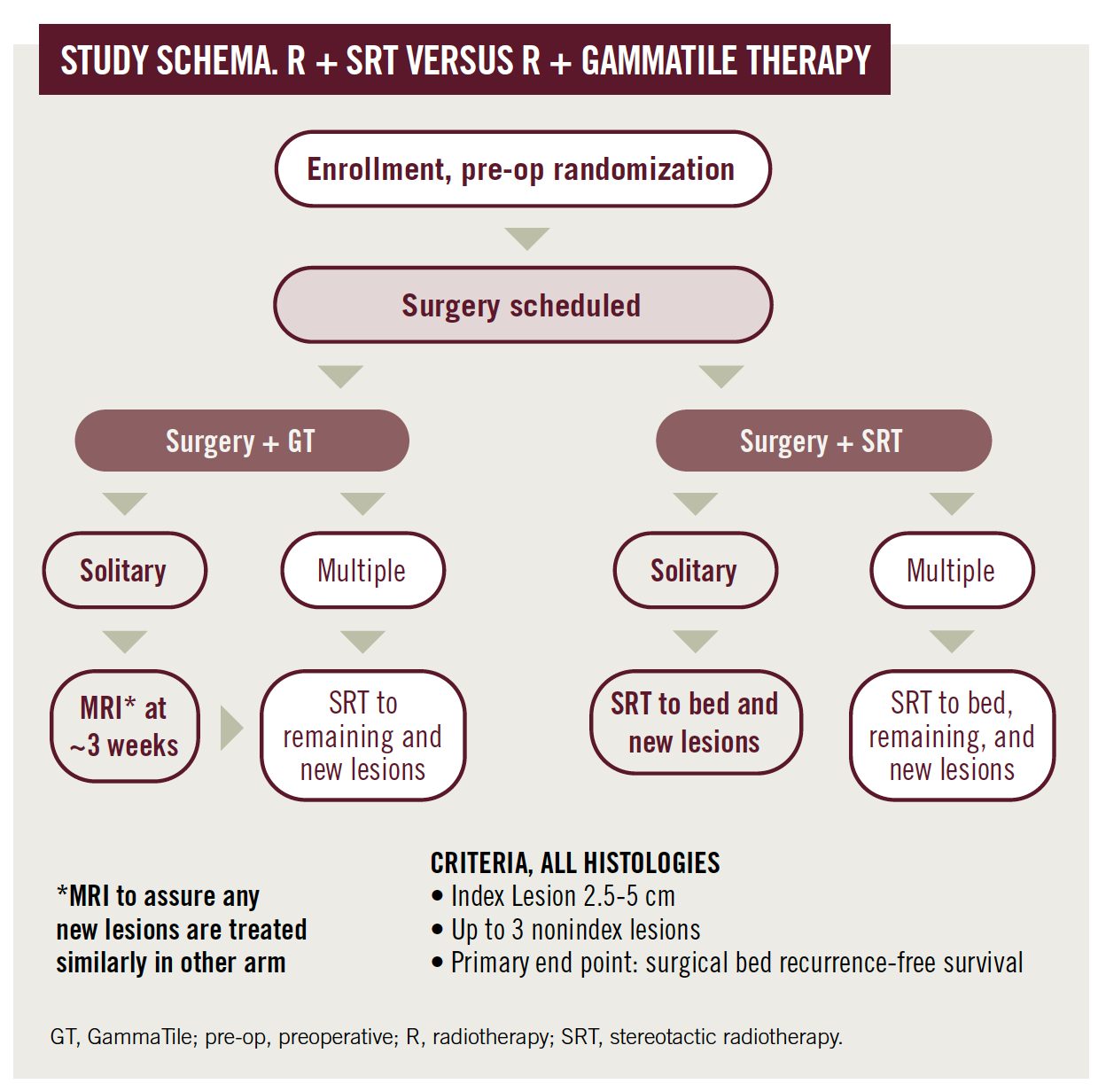Clinical Trials in Progress: ROADS Trial
Phase 3 Randomized Controlled Trial of Post-Surgical Stereotactic Radiotherapy (SRT) versus Surgically Targeted Radiation Therapy (STaRT) with GammaTile for Treatment of Newly Diagnosed Metastatic Brain Tumors (ROADS; NCT04365374)
Title
Phase 3 Randomized Controlled Trial of Post-Surgical Stereotactic Radiotherapy (SRT) versus Surgically Targeted Radiation Therapy (STaRT) with GammaTile for Treatment of Newly Diagnosed Metastatic Brain Tumors (ROADS; NCT04365374)
Background
It is estimated that 20% to 40% of all patients with cancer develop brain metastases.1 In fact, it is estimated that 200,000 new cases of brain metastases are diagnosed each year.2 The size of the metastatic lesion often drives the treatment approach taken. Larger (>2 cm) symptomatic lesions that are in an accessible location are typically resected and the surgical bed is often treated with stereotactic radiotherapy (SRT). SRT improves local control over resection alone, with a rate of local recurrence-free survival of approximately 61% to 72% at 12 months,3,4 and has become the preferred standard of care.5
However, in patients who receive SRT treatment in the postoperative setting, radiation necrosis rates can be significant, with an incidence rate upward of 18.2%.6 There is an unmet need for an adjunctive radiation therapy approach that may improve the rate of surgical bed control without the inherent risk of brain injury to normal tissue. In addition, this new therapy lowers the incidence of hair loss as an adverse effect and does not negatively impact wound healing.
GammaTile (offered by GT Medical Technologies, Inc) is an FDA-cleared device that consists of four cesium-131 radiation-emitting seeds in a collagen tile approximately the size of a postage stamp. These tiles are used to line the brain cavity immediately after resection of the tumor. This approach to Surgically Targeted Radiation Therapy (STaRT) has a number of benefits, including an immediate start of radiation treatment after tumor resection when the disease burden is at a minimum (instead of having to wait 3 to 4 weeks until the surgical wound heals); optimization of radiation dosimetry, allowing the highest dose in the region of the tumor and a lower dose in normal surrounding tissue; and visible surgical bed tissue during the time of tile placement, allowing for precise targeting of radiation therapy. Additionally, patients do not need to return as an outpatient for radiation treatment.
The purpose of this trial is to compare surgical tumor removal followed by SRT against surgical tumor removal followed by STaRT utilizing GammaTiles. The primary end point is surgical bed recurrence-free survival. Secondary end points include overall survival, physical function, neurocognitive status, quality of life, and safety. ROADS is a multicenter randomized controlled trial funded by GT Medical Technologies (NCT04365374). The study opened for enrollment in April 2021.
Key Inclusion/Exclusion Criteria
Adult patients with 1 to 4 newly diagnosed brain metastases with 1 lesion (between 2.5 cm and 5.0 cm), the largest being called the index lesion and planned for surgical resection. Nonindex lesions must measure <4.0 cm. Previous and/or concurrent treatment with systemic therapies (eg, chemotherapy, targeted therapeutics, immunotherapy) is permitted. Patients must have a Karnofsky Performance Status score of ≥70 and have stable systemic disease or reasonable systemic treatment options predicting a life expectancy of ≥6 months. Patients must be fluent in the English language to allow for completion of neurocognitive tests. Past radiation or surgical therapy to the index lesion or the newly diagnosed nonindex lesion(s) is exclusionary. However, up to a total of 2 prior courses of SRT treatment to previously diagnosed lesions are allowed, as long as any treated lesions were greater than 15 mm from the index lesion.
Patient Accrual Information
Accrual goal: 180
Percent accrued: 2% accrual completed
Study Sites
Fourteen sites are at various stages of trial activation. A total of 4 sites are open to accrual: The University of Texas MD Anderson Cancer Center, Piedmont Healthcare, University of Texas Southwestern Medical Center, and Keck School of Medicine of the University of Southern California.
STUDY SCHEMA. R + SRT VERSUS R + GAMMATILE THERAPY

CONTACT INFORMATION
COPRINCIPAL INVESTIGATOR
Jeffrey Weinberg, MD
University of Texas
MD Anderson Cancer Center
1840 Old Spanish Trail
Houston, TX 77054
Tel: 713-792-2400
Email: jweinberg@mdanderson.org
References
1. Aoyama H, Shirato H, Tago M, et al. Stereotactic radiosurgery plus whole-brain radiation therapy vs stereotactic radiosurgery alone for treatment of brain metastases: a randomized controlled trial. JAMA. 2006;295(21):2483-2491. doi:10.1001/jama.295.21.2483
2. Arvold ND, Lee EQ, Mehta MP, et al. Updates in the management of brain metastases. Neuro Oncol. 2016;18(8):1043-1065. doi:10.1093/neuonc/now127
3. Brown PD, Ballman KV, Cerhan JH, et al. Postoperative stereotactic radiosurgery compared with whole brain radiotherapy for resected metastatic brain disease (NCCTG N107C/CEC·3): a multicentre, randomised, controlled, phase 3 trial. Lancet Oncol. 2017;18(8):1049-1060. doi:10.1016/S1470-2045(17)30441-2
4. Mahajan A, Ahmed S, McAleer MF, et al. Post-operative stereotactic radiosurgery versus observation for completely resected brain metastases: a single-centre, randomised, controlled, phase 3 trial. Lancet Oncol. 2017;18(8):1040-1048. doi:10.1016/S1470-2045(17)30414-X
5. NCCN. Clinical Practice Guidelines in Oncology. Central nervous system cancers, version 1.2021. Accessed July 13, 2021. https://www.nccn.org/professionals/physician_gls/pdf/cns.pdf
6. Tanenbaum DG, Buchwald ZS, Jhaveri J, et al. Dosimetric factors related to radiation necrosis after 5-fraction radiosurgery for patients with resected brain metastases. Pract Radiat Oncol. 2020;10(1):36-43. doi:10.1016/j.prro.2019.09.014
